As a prey animal, your horse is naturally cautious of the world around him. After all, horses have survived millions of years by relying on their flight or fight instincts—their ability to flee a perceived danger or stay and fight for their lives. Horses are what I call big chickens, they’d always rather run from anything that frightens them instead of hanging around and fighting the danger. Mother Nature says, “Run!” If the horse can’t escape the danger, his only other option of survival is to fight. He’ll kick, bite, strike or do whatever it takes to survive the situation.
Your job as a horse trainer is to desensitize your horse to as many objects as you can. Your horse classifies an object as anything that doesn’t live in his stall or pasture. It’s no longer an object if it lives in his stall or pasture because he’s already familiar with it; it’s become a part of his daily routine. Horses especially hate objects that move and make a noise. So the more objects you desensitize your horse to, the quieter and more confident he’ll become. However, even if you spent every day desensitizing your horse to new objects, you’d never be able to desensitize him to everything in the world. There’s always going to be something that could potentially spook him. That’s why it’s important to know how to handle the situation when your horse does spook at an object, whether that be crossing water on the trail, fly spray, a plastic bag, the neighborhood kid riding his bike, etc. When it comes to confronting a spooky object or desensitizing their horses, most people unknowingly commit the following mistakes.
“Desensitizing a horse teaches him to ignore pressure, relax and keep his feet still. The more time you spend desensitizing your horse, the calmer and more confident he’ll be.”
Mistake #1: Forcing the Horse to Confront the Spooky Object
When a horse is frightened of an object, the worst thing you can do is force him to approach it. The more you say, “You WILL accept the clippers,” the more nervous the horse gets and thinks that there is a reason to be scared of it. If you want your horse to use the thinking side of his brain and relax rather than reverting to the reactive side of his brain and moving his feet, you have to stop being the predator that takes a direct line approach and start thinking more like your horse—a prey animal—that is cautious. Rather than forcing the object on him, you’ll use a step-by-step method to desensitize him.
Whenever you desensitize your horse to any object, you’ll always use the Approach and Retreat Method. You’ll build his confidence by approaching him with the object he is scared of and then retreating by taking the object away when he stands still and relaxes. It’s important not to take the object away if the horse is reactive and wants to move his feet. Mother Nature says, “Are you crazy? Don’t stand there, run! If you’re frightened, don’t hang around, run!”
You’re trying to say, “Don’t listen to your mother. When you get frightened, stand still and relax.” You want the horse to realize that the quickest way to get a scary object to go away is to ignore it. For example, using the Approach and Retreat Method you can teach your horse to stand still and relax while you clip him, apply fly spray or flap his body with a plastic bag. You’ll teach him that if he stands still and relaxes, the object will go away.

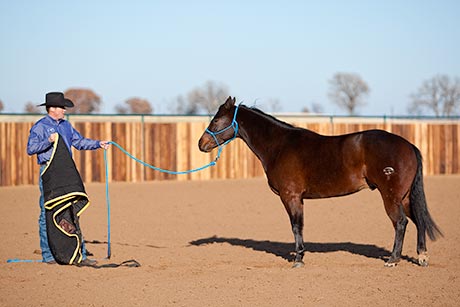
When you desensitize your horse, you’ll use the Approach and Retreat Method. You’ll approach the horse with the object, and then retreat when he keeps his feet still and shows a sign of relaxing.
The same theory applies if you encounter an obstacle on the trail that your horse is frightened of. Let’s say you come across a water obstacle and your horse plants his feet, raises his head in the air and refuses to move forward. Until they learn otherwise, most people’s first reaction is to spur the horse’s sides or spank him with the mecate to get him to go through the water. A horse that is already frightened and using the reactive side of his brain gets even more upset when you try to force him to confront the object that he’s scared of, and it becomes an all-out battle to get him in the water.
Rather than forcing the horse through the water, you can use the Approach and Retreat Method to make crossing the water his idea. In this example, you would ride the horse toward the water and just before he stopped, you’d stop him and retreat (back him away from the water), which is the complete opposite of what the horse thinks you’re going to do. He thinks you’re going to force him to step in the water, but rather than forcing him toward the scary object, you’re backing him away from it. It’s kind of like a cat and mouse game. The more you say, “Don’t go, don’t go,” the more the horse wants to get closer to the water. You build up his curiosity until eventually, he’s calmly walking through it and using the thinking side of his brain.
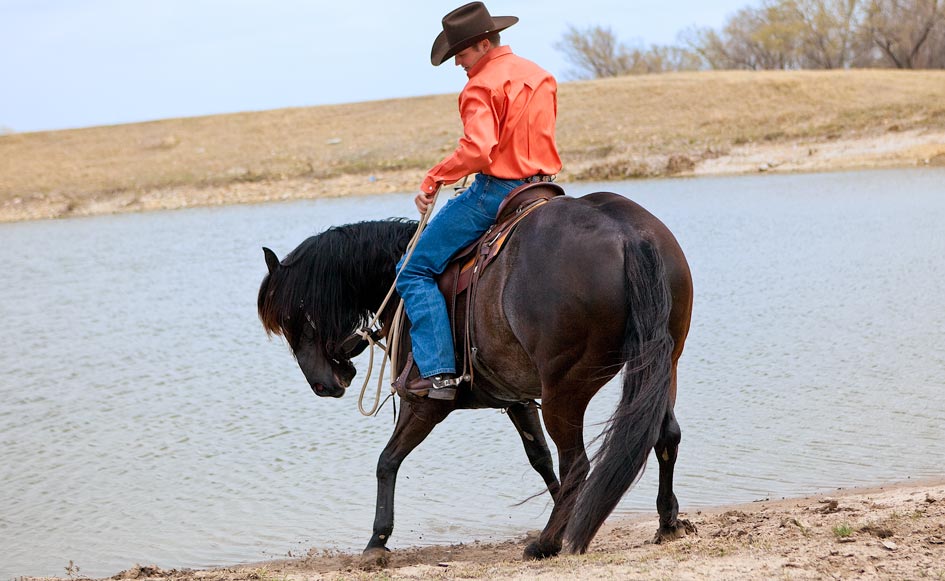
The more I practice approaching and retreating the water, the calmer and more confident Jillaroo gets until eventually she’s willing to stand in the water.
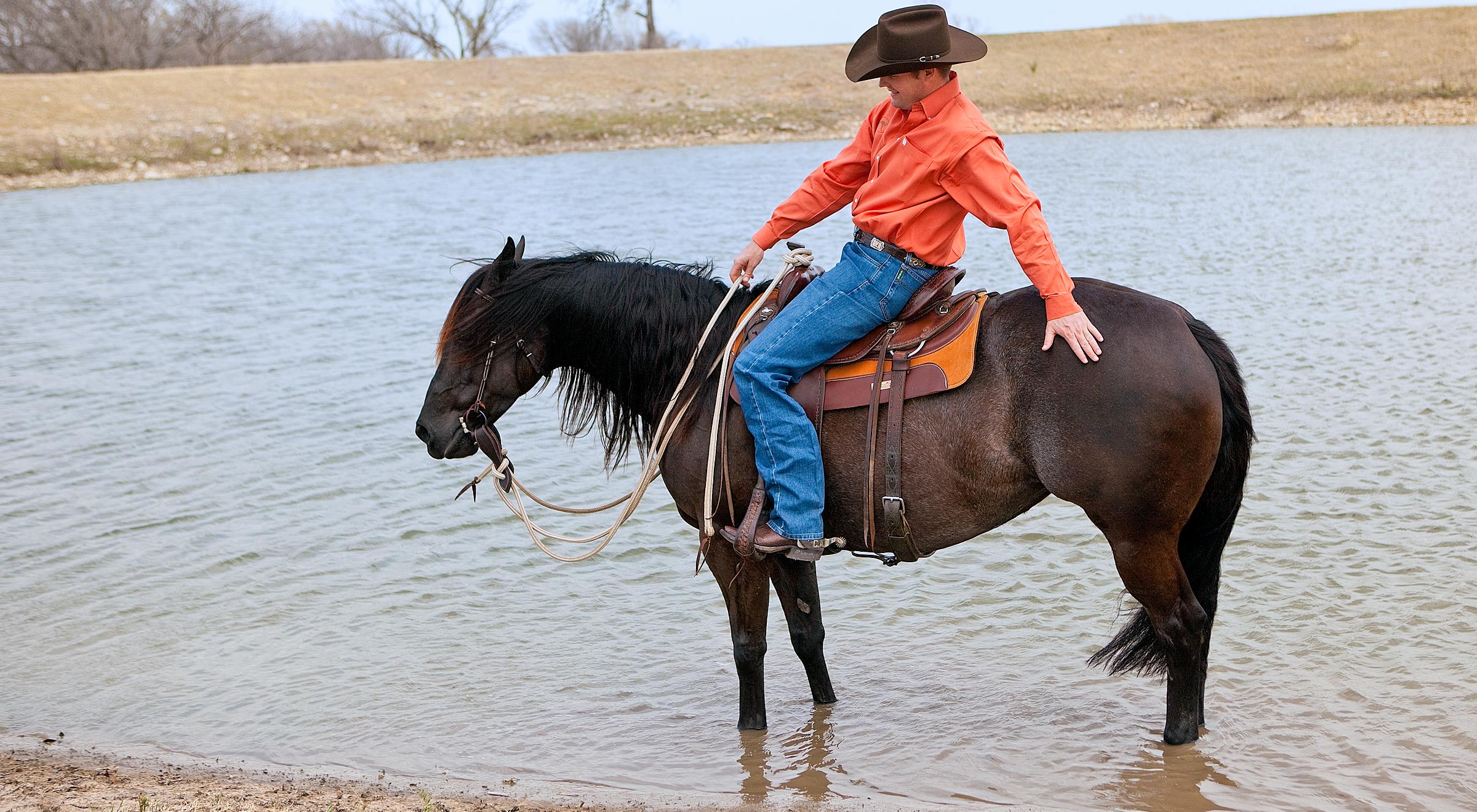
If you encounter an obstacle out on the trail, don’t force your horse to cross it. Instead, use the Approach and Retreat Method to make crossing the obstacle his idea. Here I’m retreating at the edge of the water before Jillaroo has a chance to plant her feet and refuse to move closer to it.
Mistake #2: Being Sneaky
Most people fail when it comes to desensitizing their horses to scary objects because they’re sneaky and overly cautious. They slowly walk up to the horse with the object hidden behind their back, and then very carefully try to touch the horse with it. Of course the horse gets scared and moves away because he assumes that if you’re being cautious, you must have a reason. I have a saying, “Heart attacks are free, so give one to your horse.” Or in other words, don’t tip-toe around your horse and be afraid to scare him. In reality, trying to protect your horse from objects he’s scared of only makes the situation worse. As a trainer, your goal is to desensitize your horse to as many objects that move and make a noise as you can. You can’t get that done if you’re afraid to scare him. When I’m desensitizing a horse, if he wants to get scared, that’s fine by me. Heart attacks are free. As long as I’m in a safe position, I don’t care if he has a heart attack.
In fact, on a daily basis, I try to scare my horses with objects that move and make a noise. Every time you desensitize your horse, try to do it with more intensity and with scarier objects. If you end up scaring him, that’s OK because it gives you the opportunity to make him quieter. If you can’t scare him, that’s good too because it lets you know that you’re doing a good job training him. The more objects you desensitize your horse to, the bigger the thinking side of his brain will get and the calmer he’ll be. The more you try to scare a horse, the quieter he’ll actually become.
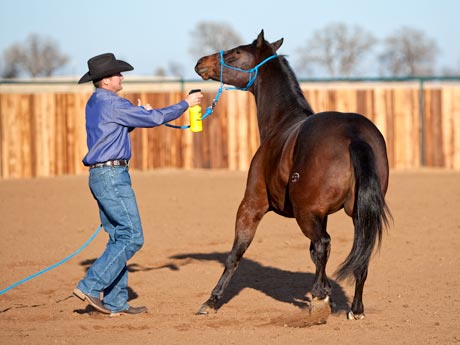
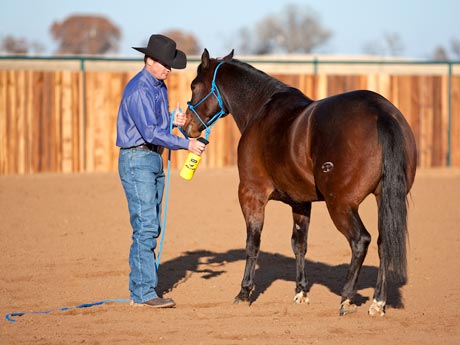
On a daily basis, I look for new objects to desensitize my horses to and try to give them heart attacks.
Mistake #3: Taking the Scary Object Away When the Horse Moves His Feet
Timing, meaning when you release the pressure is critical when training horses, especially when desensitizing. When you’re desensitizing your horse, never take the object/ pressure away until the horse stands still and shows a sign of relaxing. If you take the object away while the horse is moving his feet and using the reactive side of his brain, you’ll teach him to be scared of the object. Instead of him relaxing and standing still, he’ll think the answer to getting away from the object is to run. Using the Approach and Retreat Method, you’ll teach the horse that if he stands still and relaxes, the scary object will go away.
Remember that your horse is a prey animal with the natural desire to run from anything that scares him. You have to constantly reinforce to the horse that the answer is not to run from danger, but to stand still and relax. In fact, you’ll prove to him that when he does stand still and show a sign of relaxing, the object will go away. You want the horse to think that the only way he can feel safe is to stand still and relax.
Mistake #4: Ignoring the Spooky Object
When your horse spooks at an object or refuses to cross an obstacle, don’t just ignore it and move on. Deal with the object and teach your horse not to fear it. As a trainer, you should constantly be expanding your horse’s comfort zone. Your horse’s comfort zone is made up of the environment and objects he’s familiar and comfortable with. When you first start working with a horse, his comfort zone will be very small because he won’t have been exposed to very many objects or situations. The more you work with him and introduce new objects to him, the larger his comfort zone will become.
For example, let’s say you’re at a horse show and are riding around the arena during warm-up, and your horse spooks at a sign on the fence. Rather than ignoring his behavior and letting it get worse (ruining your chances of doing well in your class), teach him that the sign is nothing to fear. You’ll do that by moving his feet forwards, backwards, left and right in front of the sign. When a horse gets scared of an object under saddle, I love to do rollbacks in front of the object because it quickly gets him using the thinking side of his brain. You’ll use the horse’s fear of the object to get him to turn and roll back over his hocks, and each time he turns and rolls back, the closer he’ll get to the object. Horses can only think about one thing at a time. So your horse will either be thinking about the sign, or he’ll be thinking about moving his feet and paying attention to you. The more you make him move his feet, the more attention and respect you’ll get from him. Eventually, the horse will realize that doing rollbacks is much harder than actually going by the sign, and he’ll stop spooking and instead listen to you.

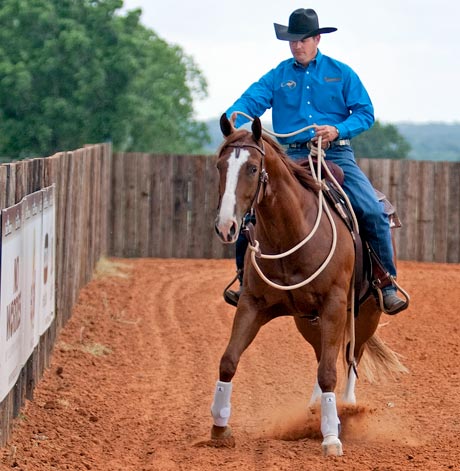
If your horse spooks at an object like Bo is doing, don’t just ignore it; fix the problem. By moving the horse’s feet around the object, it won’t be long before he’s using the thinking side of his brain and calmly passing it.
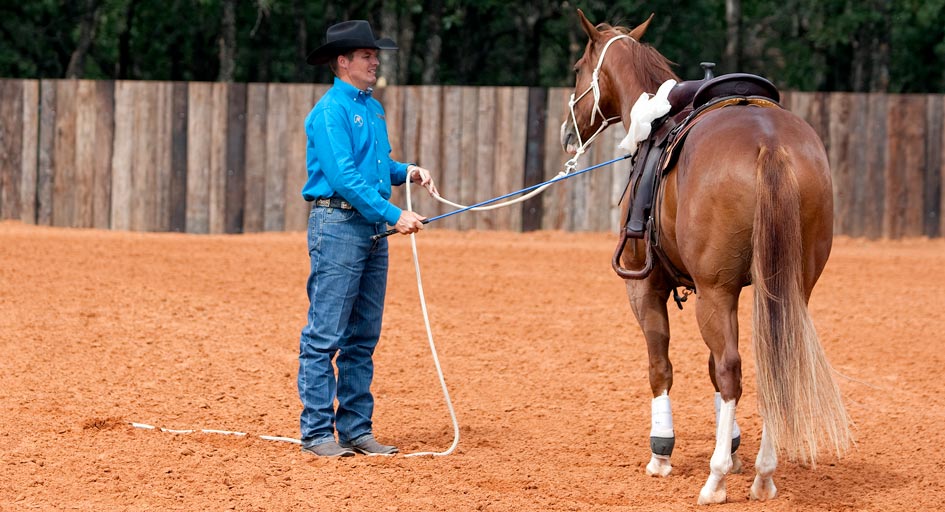
The more objects you desensitize your horse to, the bigger the thinking side of his brain will be and the calmer he’ll get.
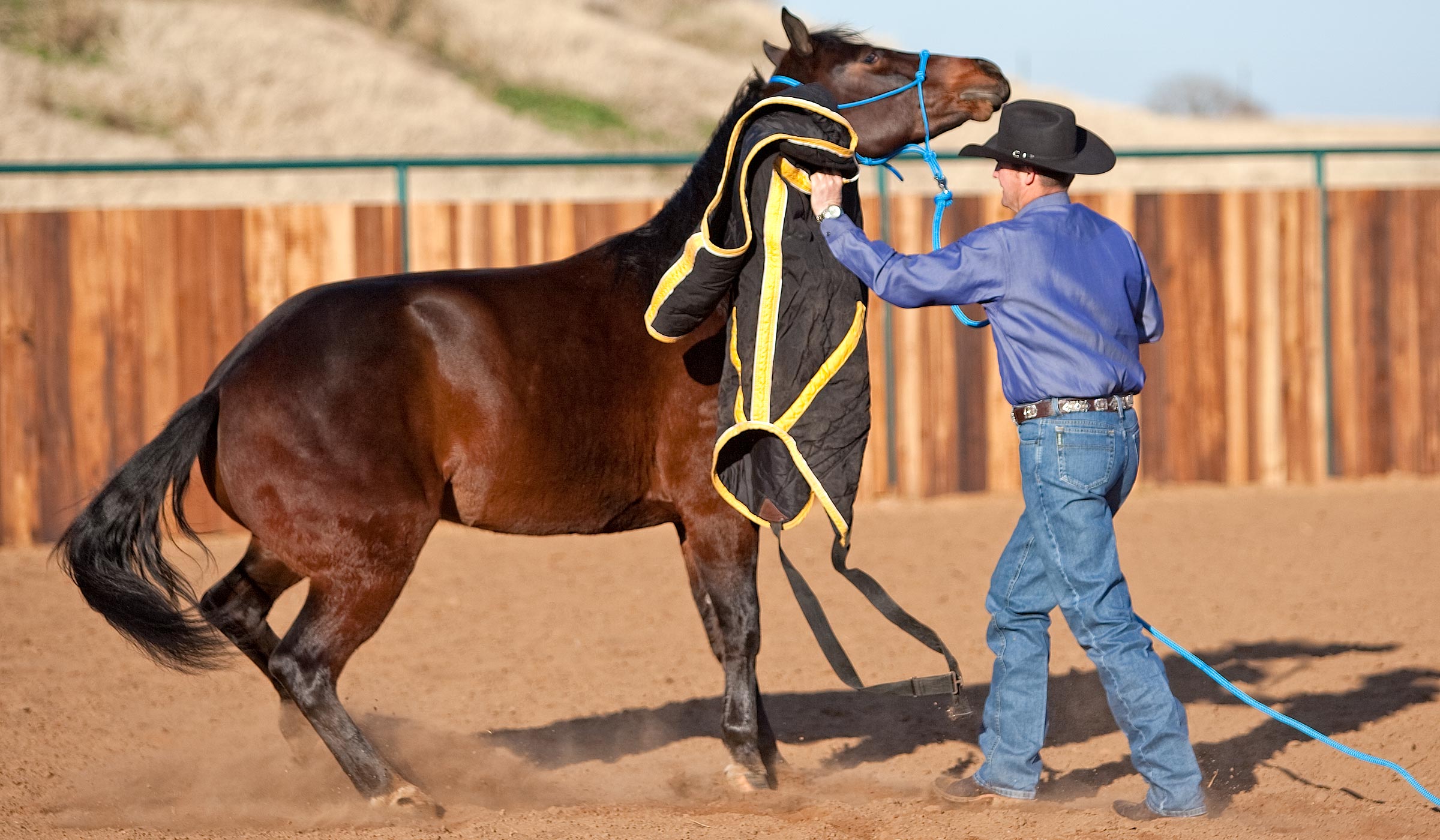
When horses are first approached with a new object, it’s normal for them to use the reactive side of their brain and resist you.
Mistake #5: Losing Your Temper
Training isn’t about emotions or feelings, it’s all business. It’s about how much the horse tries. Resistance is normal, especially when you’re introducing a new object to your horse. It’s very common for the horse to move his feet, raise his head or get nervous when you first approach him with a scary object. Don’t lose your temper when he resists you. Take your time and work through the situation. When horses are first approached with a new object, it’s normal for them to resist for two or three minutes because they know that in most cases, their owners will give up first. Now, two or three minutes might not sound like a long time right now, but when you’re out with your horse and he’s dragging you around trying to get away from the object, two or three minutes can seem like an eternity.
The majority of people quit desensitizing far too early. Instead of remaining patient and working through resistance, they give up. Getting aggressive with the horse or losing your temper isn’t the answer either. There’s no place for emotion while training.
As soon as the horse starts to try, by standing still and showing a sign of relaxing, retreat and reward him. With repetition and consistency, he’ll learn to relax as soon as you approach him with the object. He’ll realize that the longer he resists you and uses the reactive side of his brain, the longer you’re going to keep approaching him. The quicker he tries to do what you want, the quicker you’ll reward him.
The Five Signs of Relaxing
To desensitize a horse you apply pressure and continue to apply the pressure until he stands still and relaxes. When a horse relaxes, he’ll do one of five things.
- Lick his lips
- Lower his head and neck
- Cock a hind leg
- Blink his eyes
- Take a big breath
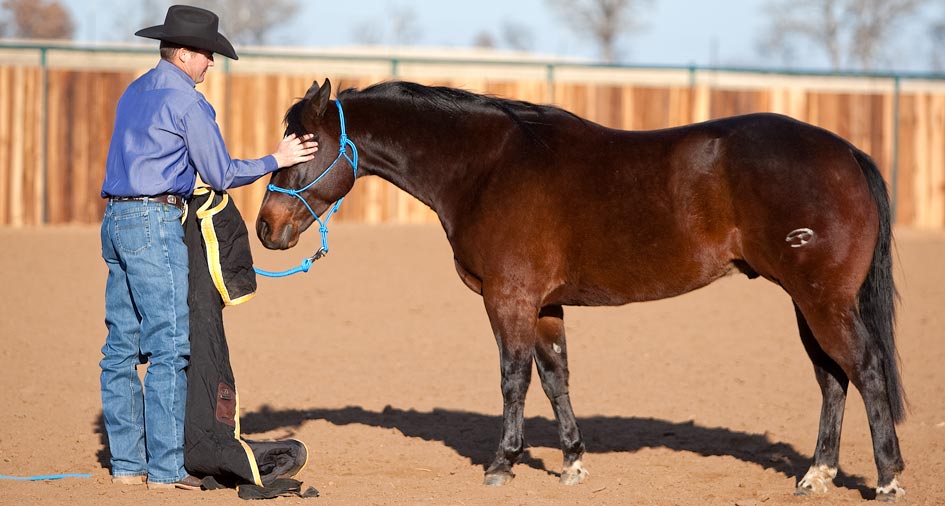
By using the Approach and Retreat Method, you’ll teach the horse that as long as he stands still and shows a sign of relaxing, you’ll leave him alone.

Master Your horsemanship Skills
Like these tips? Join the No Worries Club and hone your skills with thousands of hours of Clinton’s easy, step-by-step method horse training videos.



